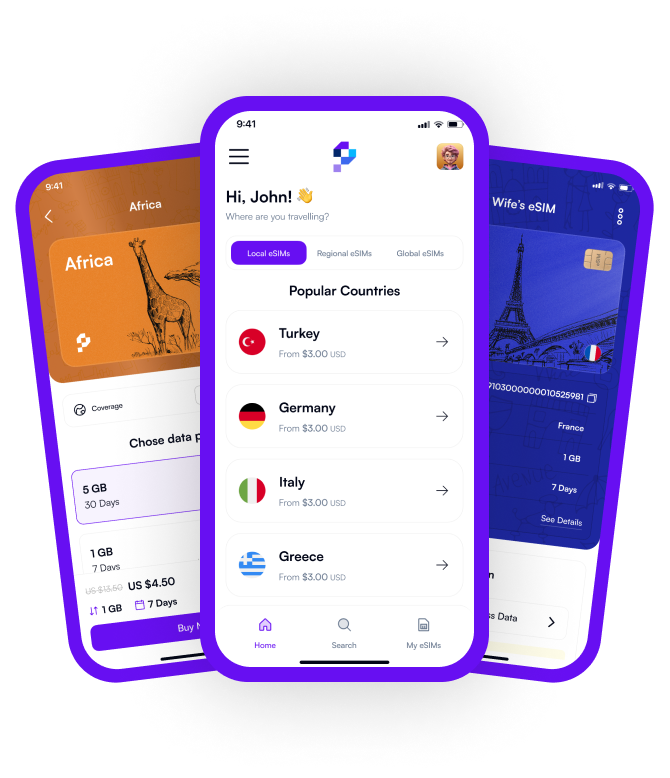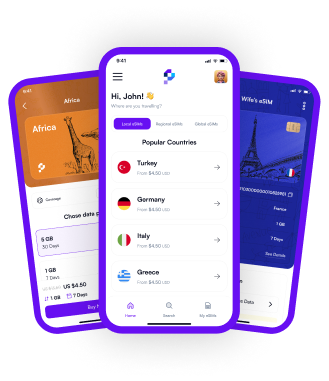Esims for Travel Guide - All Countries
Creating an ESIM (Electronic Subscriber Identity Module) for a comprehensive travel guide covering all countries is a remarkable endeavor in the realm of digital travel assistance. This ESIM would revolutionize the way travelers explore the world by providing seamless access to vital information, cultural insights, and practical tips tailored to each destination. Imagine embarking on a journey to any corner of the globe equipped with a single digital companion that effortlessly connects you to a wealth of knowledge about local customs, language essentials, must-visit landmarks, safety guidelines, and even off-the-beaten-path gems.
With this all-encompassing ESIM, travelers can bid farewell to the hassle of carrying multiple guidebooks or scouring the internet for relevant details. Whether wandering through the historic streets of Rome, trekking the majestic trails of Nepal, or snorkeling in the turquoise waters of the Maldives, this innovative travel companion ensures that adventurers are well-informed and culturally sensitive every step of the way. From practical information such as currency exchange rates and transportation options to insightful narratives about historical landmarks and culinary delights, the ESIM serves as a virtual tour guide, enriching travel experiences and fostering a deeper appreciation for the diversity of our world.
How to Get an eSIM for Multiple Countries?
Getting an ESIM for multiple countries involves a relatively straightforward process, typically facilitated by telecommunication providers offering global ESIM services. Initially, travelers need to ensure that their device is ESIM-compatible, which is increasingly common among modern smartphones and tablets. Once compatibility is confirmed, obtaining an ESIM typically involves either purchasing one directly from a telecommunication provider or acquiring a digital ESIM through an app or online platform. These ESIMs are often available as prepaid or subscription-based options, allowing users to select plans tailored to their travel needs, whether it's for a specific region or multiple countries across continents.
After acquiring the ESIM, travelers can activate it remotely through the provider's app or website, usually by scanning a QR code or entering a unique activation code. The flexibility of ESIM technology enables users to seamlessly switch between multiple mobile networks without the need to physically swap out SIM cards, making it ideal for frequent travelers or those embarking on multi-country journeys. Once activated, the ESIM provides instant access to mobile data, voice, and messaging services in the supported countries, ensuring connectivity and convenience throughout the entirety of the travel experience.
What Countries Don't Accept eSIM?
As of my last update in January 2022, the adoption of eSIM technology has been steadily growing worldwide, but there are still some countries where eSIM may not be widely accepted or supported. These countries may have regulatory or infrastructure limitations that hinder the widespread adoption of eSIM technology. Additionally, certain mobile network operators within countries may not yet offer eSIM support due to various reasons such as technical constraints or business decisions.
However, it's essential to note that the landscape of eSIM adoption is continuously evolving, and more countries and mobile network operators are likely to embrace this technology over time. As international standards for eSIM are further established and the benefits become more apparent, the acceptance of eSIMs is expected to become more widespread globally. Therefore, while there may be some countries where eSIM adoption is currently limited, the trend suggests that this limitation is likely to diminish in the future as eSIM technology becomes more ubiquitous.
What Countries Don't Allow eSIM?
As of my last update, there aren't specific countries that outright prohibit the use of eSIM technology. However, the acceptance and availability of eSIMs can vary significantly from one country to another due to factors such as regulatory frameworks, market conditions, and technological infrastructure. In some cases, certain countries may have slower adoption rates for eSIMs due to regulatory hurdles or a preference for traditional SIM card-based systems by local telecommunications authorities or providers.
It's essential for travelers to research the eSIM compatibility and availability in their destination countries before relying solely on eSIM technology for mobile connectivity. While eSIMs are becoming increasingly prevalent globally, there may still be instances where travelers encounter limitations or challenges, such as areas with limited network coverage or regions where eSIM support is not yet widespread. However, with the continued advancement of telecommunications technology and the growing demand for seamless connectivity, the acceptance and use of eSIMs are likely to expand further in the future, potentially reaching even those countries where adoption has been slower to date.
Why is a eSIM not Popular?
The popularity of eSIM technology has been steadily increasing, but it has not yet reached universal adoption due to several factors. One significant barrier to widespread adoption is the inertia of established systems and infrastructure within the telecommunications industry. Traditional SIM cards have been the standard for decades, and transitioning to eSIMs requires substantial investment in new technology and updates to existing systems, which can be time-consuming and costly for mobile network operators. Additionally, there may be resistance from some providers who are hesitant to embrace eSIMs due to concerns about potential revenue loss or disruption to their business models.
Moreover, there are also practical considerations that have slowed the pace of eSIM adoption. For instance, while eSIMs offer greater flexibility and convenience for consumers, they also introduce complexities in terms of device compatibility, activation processes, and interoperability between different network providers. This can lead to confusion among consumers and reluctance to adopt eSIM technology, especially in regions where support and awareness are still limited. Additionally, regulatory factors and security concerns may also contribute to the slower adoption of eSIMs in some markets, as policymakers and industry stakeholders work to address issues related to privacy, data protection, and consumer rights in the digital era. However, as these challenges are gradually addressed and awareness of the benefits of eSIM technology continues to grow, it is expected that eSIMs will become increasingly popular and eventually become the standard for mobile connectivity worldwide.

